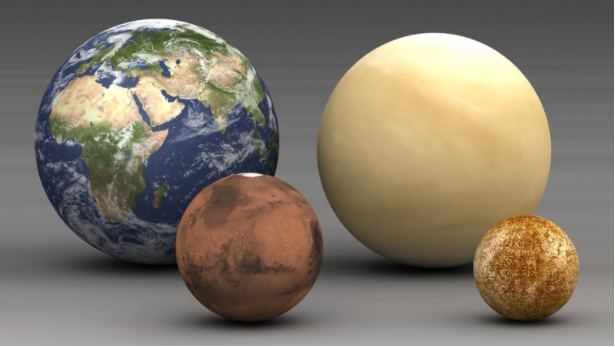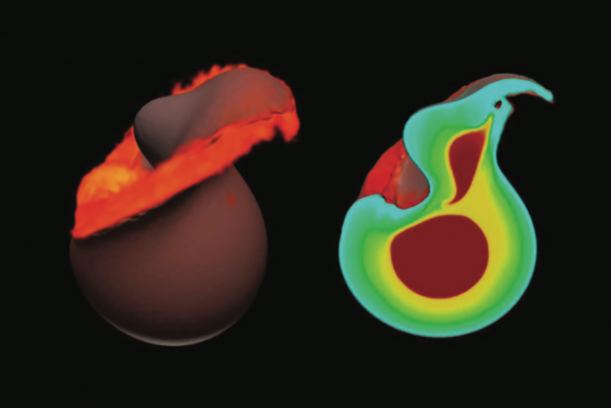Our conventional models of planet formation may have to be updated, according to a pair of new papers.
Accretion is the keyword in current planet formation theory. The idea is that the planets formed out of the solar nebula, the material left over after the Sun formed. They did this through accretion, where small particles accumulate into more massive objects. These massive boulder-sized objects, called planetesimals, continued to merge together into larger entities, sometimes through collisions. Eventually, through repeated mergers and collisions, the inner Solar System was populated by four rocky planets.
But the new research suggests that the collisions played out much differently than thought and that objects collided with each other several times, in a series of hit and runs, before merging. This research fills some stubborn holes in our current understanding.
The two new papers are published in The Planetary Science Journal. The first one looks at hit-and-runs in the late formation stages of Earth and Venus. It’s titled “Collision Chains among the Terrestrial Planets. II. An Asymmetry between Earth and Venus.” The lead author is Alexandre Emsenhuber, who was at the University of Arizona’s Lunar and Planetary Laboratory at the time this work was done.
The researchers relied on 3d simulations of giant impacts, and machine learning based on those impacts. They found that hit-and-runs or collision chains are as common as accretion events in the later stages of planetary formation, at least for Venus and Earth. And they also found that Earth acted as a kind of vanguard for Venus, helping to shepherd impactors into Venus.
The authors propose a hit-and-run-and-return model for the terrestrial planets, and have evidence to back it up. They say that the pre-planetary bodies would have spent a long time crashing into each, bouncing off, and returning to crash into each other again. Since the initial collision would have slowed them down, they’d be more likely to stick together in succeeding collisions. While the accretion model is often compared to a snowman with each snowball sticking to him, this model is more like billiards. There are successive collisions, with each collision at reduced velocities, until things calm down.
The central takeaway from the research is that giant impacts are not efficient planet-forming events.
“We find that most giant impacts, even relatively ‘slow’ ones, are hit-and-runs. This means that for two planets to merge, you usually first have to slow them down in a hit-and-run collision,” said Erik Asphaug, co-author from LPL at the University of Arizona. “To think of giant impacts, for instance the formation of the moon, as a singular event is probably wrong. More likely it took two collisions in a row.”
The first of the two papers focuses on Venus and Earth, often called “sister planets.” But for sister planets, there are some puzzling differences between the two when it comes to composition, geology, and satellite formation. The researchers think they know why.
“We think that during solar system formation, the early Earth acted like a vanguard for Venus.”
Alexandre Emsenhuber, Lead Author.
The early Solar System was a chaotic time, with objects smashing into each other. The new model shows that Earth and Venus had an unusual relationship. They say that Earth acted as a kind of vanguard for Venus. As objects struck Earth and bounced off they, many of them were sent toward Venus at a lower velocity. In this way, Venus accreted more objects from the outer Solar System.
“The Earth acts as a shield, providing a first stop against these impacting planets,” Asphaug said. “More likely than not, a planet that bounces off of Earth is going to hit Venus and merge with it.” Part of the reason for this is that the Solar System is like a gravity well. The closer an object gets to the Sun, the more likely it is to stay there. Since Venus is closer, more objects stuck to it after hitting Earth and bouncing off. “…an impactor that collides with Venus is pretty happy staying in the inner solar system, so at some point it is going to hit Venus again,” Asphaug explained.

But Earth has no vanguard. There’s nothing to slow down interloping objects from the outer Solar System. As a result, many objects just bounced off. And since objects are drawn to the center of the gravity well, they’re not likely to encounter Earth again. Instead they encounter Venus. This discrepancy could account for the differences between Venus and Earth. In low-velocity hit-and-runs “… the runner is an identifiable remnant of the projectile (eg a mantle-stripped core, sometimes barely so)…” the authors write.
“The prevailing idea has been that it doesn’t really matter if planets collide and don’t merge right away, because they are going to run into each other again at some point and merge then,” Emsenhuber said. “But that is not what we find. We find they end up more frequently becoming part of Venus, instead of returning back to Earth. It’s easier to go from Earth to Venus than the other way around.”
In most hit-and-runs, most of the projectile survives the impact. But its velocity can be greatly reduced, and its trajectory changed. If the runner is slowed down enough, then both bodies can stay gravitationally bound to one another. In that case, the researchers call it a graze-and-merge.
The paper reached four related conclusions.
- The terrestrial planets weren’t isolated from each other during the later stages of planetary formation. Escaping runners from a hit-and-run with one planet are likely to collide with another planet.
- Long collision chains are less likely because the projectile needs such a high initial velocity, and high velocity runners are less likely to return.
- Earth served as a vanguard for Venus, slowing late stage projectiles and sending them toward Venus. Earth only accreted about half of the projectiles, at most, that collided with it.
- Runners from Earth are about equally as likely to collide with Venus as they are to return to Earth. But Venus retains the majority of its runners.
The Moon
The second paper deals with the Moon and its formation. It’s title is “Collision Chains among the Terrestrial Planets. III. Formation of the Moon.” It’s also published in The Planetary Science Journal. The lead author is Erik Asphaug, of the LPL at the University of Arizona.
The prevailing theory says that the young Earth was struck by a planet named Theia about 4.5 billion years ago. Earth has a larger core than it should have for its size, and that came from Theia. The impact destroyed Theia, and much of its mass was sent into orbit around Earth. Eventually it coalesced into the Moon.
But there are some unresolved problems in this scenario. The collision velocity would have to be very low, and the isotope composition of the Earth and the Moon are almost identical. A single low-velocity impact wouldn’t allow all the material to be mixed up enough for the isotope compositions to be so similar.
“The standard model for the moon requires a very slow collision, relatively speaking,” Asphaug said, “and it creates a moon that is composed mostly of the impacting planet, not the proto-Earth, which is a major problem since the moon has an isotopic chemistry almost identical to Earth.”
“The “graze-and-merge” collision strands a fraction of Theia’s mantle into orbit, while Earth accretes most of Theia and its momentum,” the authors write in their paper. “However, a Moon that derives mostly from Theia’s mantle, as angular momentum dictates, is challenged by the fact that O, Ti, Cr, radiogenic W, and other elements are indistinguishable in Earth and lunar rocks.”

In the team’s new model, there’s not a single collision, but two. When Theia collides with Earth, it’s moving a bit faster, and bounces off Earth in a hit-and-run. About one million years later it returns. It collides with Earth again, in a giant impact similar to the existing model.
“The double impact mixes things up much more than a single event,” Asphaug said, “which could explain the isotopic similarity of Earth and moon, and also how the second, slow, merging collision would have happened in the first place.”

This new model of hit-and-run impacts and chains of collisions has the potential to explain some puzzling things about the terrestrial planets. If the standard accretion model is correct, why are the inner planets so different? Why doesn’t Venus have a moon of its own? Why does Earth have a strong magnetic shield and Venus such a weak one?
Asphaug says their research helps explain how these difference could have arisen.
“In our view, Earth would have accreted most of its material from collisions that were head-on hits, or else slower than those experienced by Venus,” he said. “Collisions into the Earth that were more oblique and higher velocity would have preferentially ended up on Venus.”
Common sense suggests that Earth would have more material from the outer Solar System because its closer to it than Venus is. But this research suggests the opposite. Projectiles from the outer Solar System would be likely travelling faster, so would bounce off Earth in a hit-and-run. Many of those projectiles would have found their way to Venus and become part of that planet. So Venus’ differences could be chalked up to its greater component of outer Solar System material.
“You would think that Earth is made up more of material from the outer system because it is closer to the outer solar system than Venus. But actually, with Earth in this vanguard role, it makes it actually more likely for Venus to accrete outer solar system material,” Asphaug said.
This research could also explain why Venus has no Moon, even though this hypothesis makes it more likely for the planet to acquire one. “While Venus may have been more likely than Earth to have acquired a massive satellite by our hypothesis, it may also have been more likely to have lost one,” the authors write. “For the same reason that Venus reaccretes a greater fraction of its runners, compared to Earth, it also reaccretes a greater fraction of its giant impact debris, of which it produces more for a given projectile.” Since Venus’ orbit is smaller than Earth, impact debris will collide with it sooner. All that returning debris could erode or even destroy any natural satellite that Venus may have acquired.
Overall, this research suggests a greater interconnectedness among the terrestrial planets. A greater understanding of the Moon’s geology, layering, and solidification could help confirm the new model. So could surface samples from Venus.
But that’s a ways off in the future.
More:
- Press Release: Earth and Venus Grew Up as Rambunctious Planets
- Paper: Collision Chains among the Terrestrial Planets. II. An Asymmetry between Earth and Venus
- Paper: Collision Chains among the Terrestrial Planets. III. Formation of the Moon
- Universe Today: The First Images and Videos from the Double Venus Flyby

